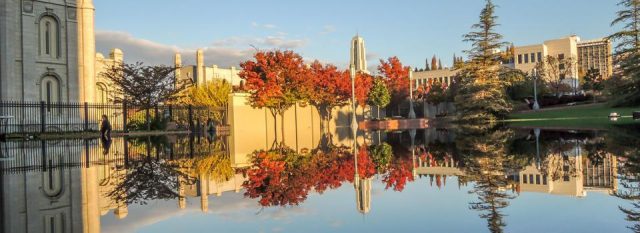
This was a momentous general conference with lots of exciting changes to help the Church move forward. Below is a list of nine major changes that were announced.
- Policy about witnesses to ordinances. (Russell M. Nelson, Oct. 2, General Conference Leadership Meeting, also see First Presidency letter)
- Any baptized member of the Church may serve as a witness of the baptism of a living person. This change pertains to all baptisms outside the temple.
- A proxy baptism for a deceased person may be witnessed by anyone holding a current temple recommend, including a limited-use temple recommend.
- Any endowed member with a current temple recommend may serve as a witness to sealing ordinances, living and proxy.
- “Gender” in The Family: A Proclamation to the World refers to “biological sex at birth.” (Dallin H. Oaks, Oct. 2, General Conference Leadership Meeting)
- Adjustment of Aaronic Priesthood and Young Women curriculum topics to align with Come, Follow Me. (Saturday morning session, Stephen W. Owen)
- Callings and releases. Some General Authority Seventies and Area Seventies were released and others were called. (Saturday afternoon session, Henry B. Eyring)
- Adjustments in Aaronic Priesthood and Young Women Organizations (Saturday afternoon session, Elder Quentin L. Cook and General Women’s Session, Sister Bonnie H. Cordon)
- The young men and young women of the ward are the bishop’s first responsibility and priority.
- The callings of ward Young Men president, counselors, and secretary are now discontinued.
- The bishopric will be assisted by Aaronic Priesthood quorum advisers and Young Women leaders.
- The Young Women president reports directly to the bishop.
- Like other ward officers, the Young Women president strives to lift the load of the bishop, where appropriate by helping young women regarding issues that do not require the bishop’s keys as a common judge and that do not involve abuse.
- Youth quorum and class presidencies plan and conduct Sunday meetings, service projects, and other activities.
- Quorum and class presidencies focus on the work of salvation, including (1) member missionary work, (2) convert retention, (3) activation, (4) temple and family history work, and (5) teaching the gospel.
- The bishopric youth committee is now the ward youth council to focus on encouraging members to help bring others to Jesus Christ and to take an active role in the work of salvation. The only adults who attend this council is the bishopric and the Young Women president.
- Quorum and class presidency orientation resources are now available.
- Activities for youth are no longer called “Mutual” but can be called “Young Women activities,” “Aaronic Priesthood quorum activities,” or “youth activities.”
- The budget allowance for youth activities should be divided between the young men and young women with equal proportions, according to the number of youth in each organization.
- The budget for Primary activities should be divided between the boys and girls with equal proportions, according to the number of children.
- The Young Women Theme has been revised.
- Young Women classes should be divided according to the number and needs of the young women.
- The Young Women class names Beehive, Mia Maid, and Laurel will no longer be used. Classes will be named “Young Women,” and then the ages of young women in the class, such as “Young Women 12–14,” “Young Women 15–18,” or “Young Women,” if all meet together.
- Young women progress between classes as age-groups at the beginning of January in the year they turn the age of the next class.
- Each Young Women class should have one adviser.
- Young Women Specialists may be called to assist the presidency and advisers, in either long-term roles or to assist with a particular event such as a camp or youth conference.
- The callings of Young Men president, counselors in the Young Men presidency, and Young Men secretary have been discontinued at the ward level.
- Each Aaronic Priesthood quorum should have one adviser.
- Aaronic Priesthood specialists may be called to assist the presidency and advisers, in either long-term roles or to assist with a particular event such as a camp or youth conference.
- A member of the high council serves as stake Young Men president. His counselors can be called from the membership of the stake or can be the high councilor assigned to Young Women and the high councilor assigned to Primary. A stake Young Men secretary is a brother called from the membership of the stake.
- The stake Young Men presidency serves on the stake Aaronic Priesthood–Young Women committee with the stake Young Women presidency, the high councilor assigned to Young Women, and the high councilor assigned to Primary.
- Stake Sunday School Presidency. A member of the high council will now serve as the stake Sunday School president and may serve with or without counselors and a secretary. He may serve on the stake Aaronic Priesthood–Young Women committee.
- Change of “Auxiliary” to “Organization.” At the general, stake, and ward levels, Relief Society, Young Women, Young Men, Primary, and Sunday School will be referred to as “organizations” rather than “auxiliaries.” Leaders will be referred to as “General Officers,” “stake officers,” and “ward officers.”
- New Temples. Temples will be constructed in Freetown, Sierra Leone; Orem, Utah; Port Moresby, Papua New Guinea; Bentonville, Arkansas; Bacolod, Philippines; McAllen, Texas; Cobán, Guatemala; and Taylorsville, Utah
- Updates to temple recommend interview questions. Temple standards stay the same, but some of the questions were reworded to be clearer.
Continue reading at the original source →



